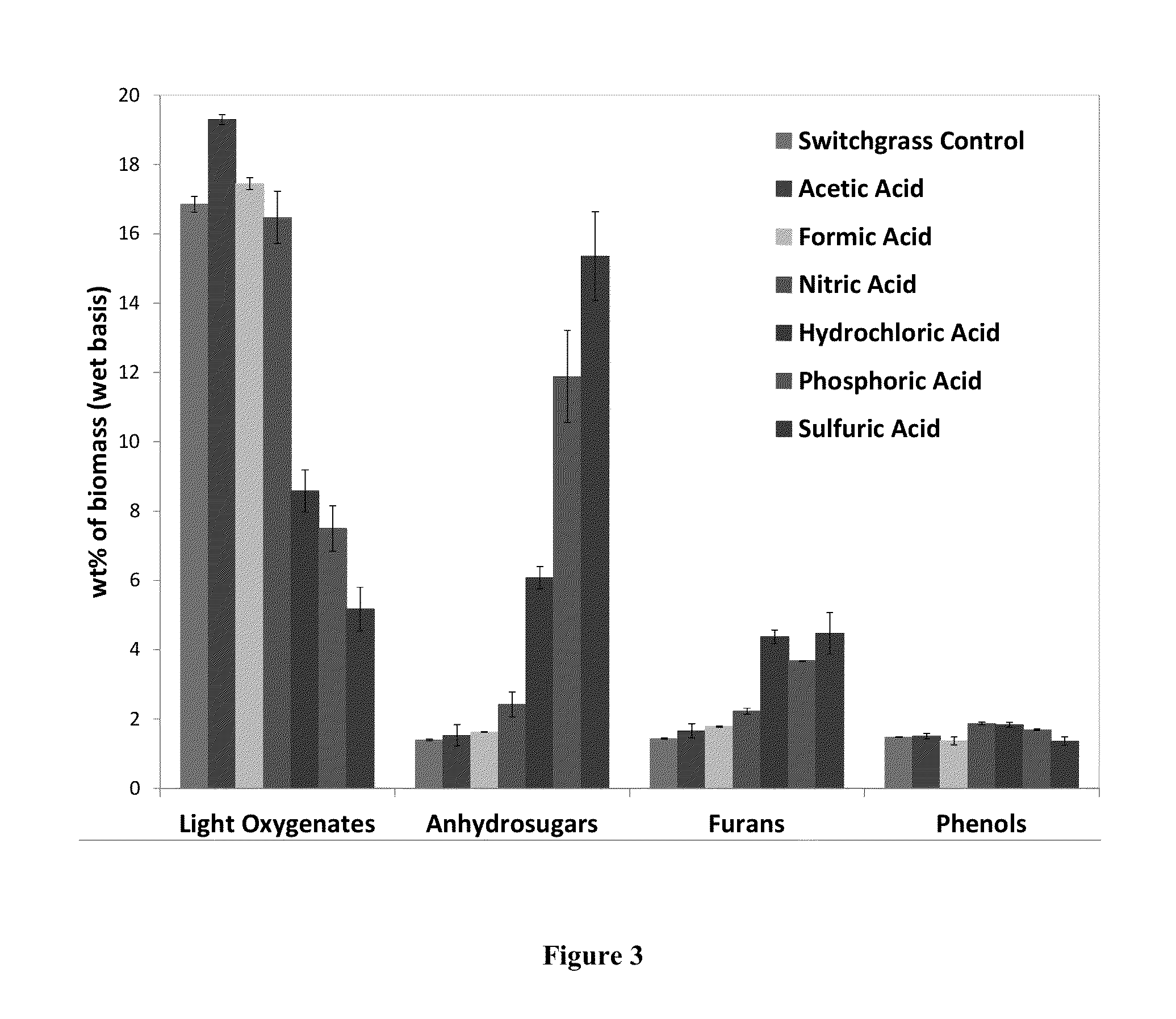Method for pretreating lignocellulosic biomass
a lignocellulosic and biomass technology, applied in the field of lignocellulosic biomass pretreatment, can solve the problems of inability to thoroughly wash and dry biomass prior to pyrolysis, inability to achieve thorough pyrolysis and subsequent drying, and inability to achieve rapid pyrolysis, etc., to achieve the effect of reducing the catalytic activity of aaem and reducing the fragmentation of catalytic saccharide rings
- Summary
- Abstract
- Description
- Claims
- Application Information
AI Technical Summary
Benefits of technology
Problems solved by technology
Method used
Image
Examples
example 1
Materials and Methods
[0064]Both woody biomass (red oak and loblolly pine) and herbaceous biomass (switchgrass and cornstover) were investigated Examples 1-6, which provided a wide range of naturally occurring alkali and alkaline earth metals (AAEM) concentrations. Typically, woody biomass contains less than 500 ppm of AAEM, while herbaceous biomass can contain more than ten times this amount of AAEM.
example 2
Determination of Structural Composition of Biomass
[0065]The structural composition of biomass was determined by extracting the cell wall of biomass and analyzing the content of cellulose, hemicellulose, and lignin. Five hundred grams of each biomass sample were dried and milled to 212-500 μm size. The plant material was homogenized in 80% (v / v) ethanol using a Polytron Homogenizer (Fisher, USA) at high speed for 2-3 minutes. Homogenate was heated for 1 hour at 80° C., cooled down to room temperature, and centrifuged at 12000 times gravity (G) for 30 minutes. Pellets were resuspended in 80% ethanol, and the procedure was repeated. Pellets were washed three times with 85% acetone, and air dried. Dry pellets were suspended in 0.5% aqueous sodium dodecyl sulfate (SDS) overnight. The residue was recovered and washed with water by filtration, washed with a 1:1 mixture of chloroform and methanol, rinsed with acetone, and air-dried. The resulting cell wall material (CW) was analyzed.
[0066]C...
example 3
Determination of Cation, Chlorine, and Moisture Content of the Biomass
[0073]Cation Content
[0074]The cation content of the feedstocks was determined using an Inductively Coupled Plasma Spectrometer (ICP) with the standard acid digestion method ASTM D6349 (Standard test method for determination of major and minor elements). The measured AAEM content of each feedstock is listed in Table 2.
[0075]Chlorine Content
[0076]The chlorine content of the feedstocks was determined using ion chromatography.
[0077]Moisture Content
[0078]The moisture content was determined using a Mettler Toledo Thermogravimetric Analyzer (TGA) by subjecting 10 mg of a sample to a nitrogen atmosphere at 105° C. for 10 minutes. The resulting mass loss was assumed to be moisture.
[0079]All the above tests in this example were run in duplicates and standard deviations were determined. As shown in Table 2, the pretreated feedstocks were dried to similar moisture contents.
PUM
| Property | Measurement | Unit |
|---|---|---|
| temperature | aaaaa | aaaaa |
| temperatures | aaaaa | aaaaa |
| temperatures | aaaaa | aaaaa |
Abstract
Description
Claims
Application Information
 Login to View More
Login to View More - R&D
- Intellectual Property
- Life Sciences
- Materials
- Tech Scout
- Unparalleled Data Quality
- Higher Quality Content
- 60% Fewer Hallucinations
Browse by: Latest US Patents, China's latest patents, Technical Efficacy Thesaurus, Application Domain, Technology Topic, Popular Technical Reports.
© 2025 PatSnap. All rights reserved.Legal|Privacy policy|Modern Slavery Act Transparency Statement|Sitemap|About US| Contact US: help@patsnap.com



